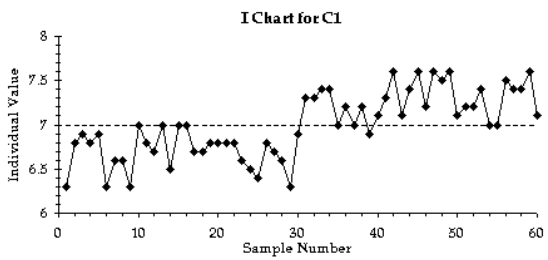500 câu trắc nghiệm Kinh tế lượng – 13B

Tổng hợp 500 câu trắc nghiệm + tự luận Kinh tế lượng (Elementary Statistics). Tất cả các câu hỏi trắc nghiệm + tự luận đều có đáp án. Nội dung được khái quát trong 13 phần, mỗi phần gồm 3 bài kiểm tra (A, B, C). Các câu hỏi trắc nghiệm + tự luận bám rất sát chương trình kinh tế lượng, đặc biệt là phần thống kê, rất phù hợp cho các bạn củng cố và mở rộng các kiến thức về Kinh tế lượng. Các câu hỏi trắc nghiệm + tự luận của phần 13B bao gồm:
SHORT ANSWER. Write the word or phrase that best completes each statement or answers the question. Provide an appropriate response.
1) Describe what process data are. Why are process data important to businesses? What is a common goal of businesses using quality control?
Process data are data arranged according to some time sequence. Process data are important to businesses because important characteristics of process data can change over time, and businesses are interested in ensuring quality by controlling these important characteristics. Businesses using quality control are interested in reducing variability in characteristics of their product.
2) Define statistically stable (or “within statistical control”). Show examples of run charts which illustrate processes which are not statistically controlled. Discuss the pattern which indicates the process is not statistically controlled for each example.
A process is statistically stable if it has only natural variation, with no patterns, cycles, or any unusual points. Any of the graphs in Figure 13-2 would apply: graphs with an obvious upward or downward trend, graphs with an upward or downward shift (relatively stable values for the first few, a shift, relatively stable values at the end), graphs with one exceptionally high or low value, graphs with cyclical behavior, or graphs whose variation is increasing over time.
Construct a run chart for individual values corresponding to the given data.
3) A machine that is supposed to fill small bottles to contain 20 ml yields the following data from a test of 4 bottles every hour.
| S | A | M | R |
| 1 | 19.9 20.1 20.2 20.3 | 20.125 | 0.4 |
| 2 | 20.4 20.0 20.3 20.3 | 20.25 | 0.4 |
| 3 | 20.0 20.7 20.4 20.3 | 20.35 | 0.7 |
| 4 | 20.4 20.1 20.1 19.9 | 20.125 | 0.5 |
| 5 | 19.9 19.8 19.6 19.5 | 19.7 | 0.4 |
| 6 | 19.4 19.4 19.6 19.7 | 19.525 | 0.3 |
| 7 | 19.8 19.4 19.6 19.7 | 19.625 | 0.4 |
| 8 | 19.9 19.8 20.0 20.0 | 19.925 | 0.2 |
| 9 | 20.2 20.3 20.1 20.3 | 20.225 | 0.2 |
| 10 | 20.0 20.3 20.0 20.2 | 20.125 | 0.3 |
| 11 | 20.3 20.5 20.1 20.2 | 20.275 | 0.4 |
| 12 | 20.1 19.9 19.8 19.7 | 19.875 | 0.4 |
| 13 | 19.5 19.8 19.7 19.6 | 19.65 | 0.3 |
| 14 | 19.4 19.8 19.8 19.4 | 19.4 | 0.4 |
| 15 | 19.5 19.6 19.6 19.9 | 19.65 | 0.4 |


Construct an R chart and determine whether the process variation is within statistical control.
4) A machine is supposed to fill cans that contain 12 oz. Each hour, a sample of four cans is tested;
the results of 15 consecutive hours are given below.
| S | A | M | R |
| 1 | 11.2 11.7 11.8 11.7 | 11.6 | 0.6 |
| 2 | 11.8 11.3 11.6 11.6 | 11.575 | 0.5 |
| 3 | 11.3 12.0 11.8 11.7 | 11.7 | 0.7 |
| 4 | 12.1 11.6 12.1 12.0 | 11.95 | 0.5 |
| 5 | 11.8 11.8 11.9 11.9 | 11.85 | 0.1 |
| 6 | 12.0 11.9 11.8 11.7 | 11.85 | 0.3 |
| 7 | 11.6 12.0 11.9 11.8 | 11.825 | 0.4 |
| 8 | 11.5 12.1 11.9 12.0 | 11.875 | 0.6 |
| 9 | 12.1 12.1 11.7 11.9 | 11.95 | 0.4 |
| 10 | 11.7 12.0 11.6 11.9 | 11.8 | 0.4 |
| 11 | 12.1 12.4 11.9 12.2 | 12.15 | 0.5 |
| 12 | 12.5 12.0 12.4 12.3 | 12.3 | 0.5 |
| 13 | 12.5 12.0 12.1 12.1 | 12.175 | 0.5 |
| 14 | 12.4 12.0 12.0 12.4 | 12.2 | 0.4 |
| 15 | 12.4 12.4 12.6 12.1 | 12.375 | 0.5 |


Construct a control chart for \({\bar x}\).